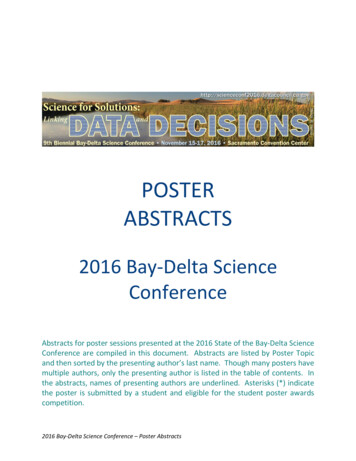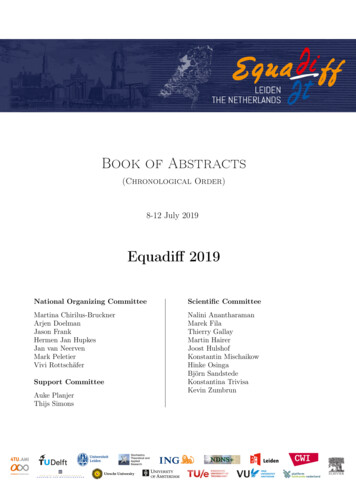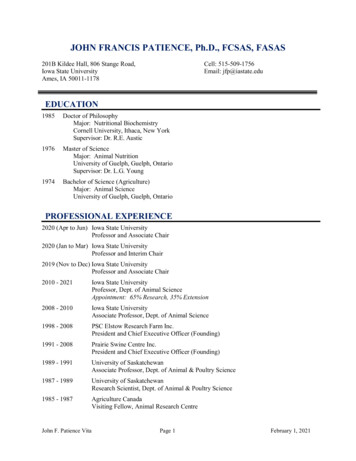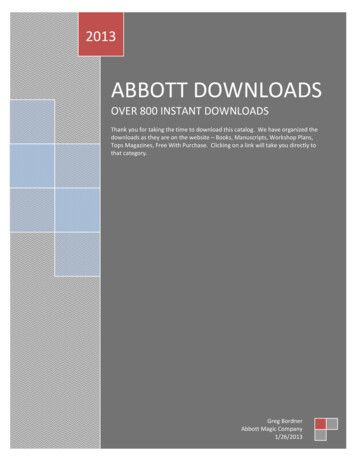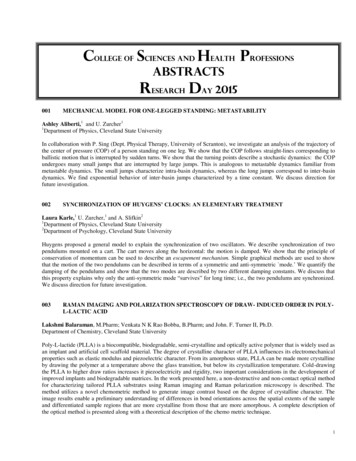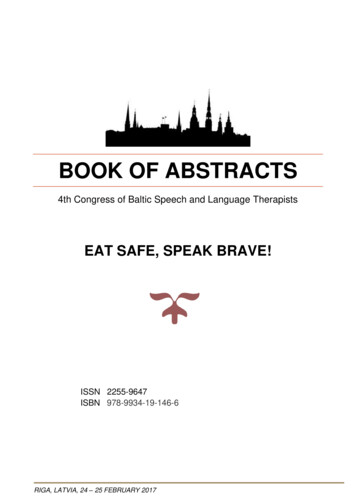
Transcription
BOOK OF ABSTRACTS4th Congress of Baltic Speech and Language TherapistsEAT SAFE, SPEAK BRAVE!ISSN 2255-9647ISBN 978-9934-19-146-6RIGA, LATVIA, 24 – 25 FEBRUARY 2017
1Book of Abstracts of the Congress of Baltic Speech and Language TherapistsRiga, Latvia, February 24 – 25, 2017.Speech Therapists’ Association of Latvia: Riga, 2017.Edited by Egija Laganovska, Sarmīte TūbeleThe accuracy of the abstracts is responsibility of the authors.ISSN 2255-9647ISBN 978-9934-19-146-64st Congress of Baltic Speech and Language TherapistsRIGA, LATVIA, 24 – 25 FEBRUARY 2017
Scientific CommitteeBaiba Trinite, PhD, Assistant Professor, Liepaja University, LatviaSarmite Tubele, PhD, Professor, University of Latvia, LatviaGundega Tomele, MSc, Lecturer Liepaja University, LatviaHazel Roddam, PhD, Reader in Allied Health Practice School of health Sciences,University of Central Lancashire (UCLan)Heike Münch, PhD, lecturer, University of Graz, AustriaDaiva Kairiene, PhD, lecturer, Siauliai University, LithuaniaFrédéric Martin, Speech – Language therapist, FranceOrganizing CommitteeBaiba Trinite, President of Speech Therapists’ Association of LatviaGunta Ozolina, VicepresidentIja Bauska, executive directorIlze Martinsone, training centre directorSarmite Tubele, board memberInara Klavina, board memberZeltite Sneidere, board memberRamona Straume, board memberLudmila Gomačenko, board memberJolanta Hanzovska, board memberValda Krauze, secretaryEgija Laganovska, secretary4st Congress of Baltic Speech and Language TherapistsRIGA, LATVIA, 24 – 25 FEBRUARY 20172
ContentGeneral Information . 5Congress General Sponsor . 6 3Keynote Speakers . 7Frederic MartinSWALLOWING AND FEEDING DISORDER IN ADULTS: A PRIMARY ROLE FOR THESPEECH – LANGUAGE THERAPIST. FRENCH EXPERIENCE . 10Hazel RoddamPROFESSIONAL ISSUES IN PAEDIATRIC DYSPHAGIA: WHAT ARE THEIMPLICATIONS FOR RESEARCH AND CLINICAL PRACTICE? . 11Heike MünchCLINICAL EVALUATION AND INTERVENTION OF OROFACIAL FUNCTIONS . 13Mare Laidra, Aaro Nursi, Marika Padrik, Helena OselinTHE COMPARISON OF THE RESULTS OBTAINED IN CLINICAL SWALLOWINGEVALUATION AND VIDEOFLUOROSCOPIC EVALUATION IN ADULTS WITHNEUROLOGICAL DISEASE . 14Dace MarkusPHONEME PRONUNCIATION TEST: PROGRESS AND DIFFICULTIES . 16Jean-Laurent Astier KaranauskasCLINICAL ASSESSMENT IN SPEECH AND LANGUAGE THERAPY (SLT): ASCIENTIFIC APPROACH . 18Daiva KairieneTREATMENT OF ARTICULATION DISORDERS IN CHILDREN: MOTOR LEARNINGAPPROACH. 20Baiba Trinite, Valda Krauze, Megija Pīra, Gundega ŠteindaleVOICE ERGONOMICS RISK FACTORS IN TEACHERS . 22Gundega Tomele, Mara AntonevičaPREVENTION OF READING DISORDERS IN 6 TO 7 YEARS OLD CHILDREN . 24Laura Laugale, Gundega TomeleROLE OF PARENTS IN A CHILDREN’S EARLY SPEECH AND LANGUAGEDEVELOPMENT . 27Poster presentations . 30Ilva Liepa, Baiba TriniteTHE INFLUENCE OF TEACHERS’ DYSPHONIC VOICE ON PUPILS’ LANGUAGEPERCEPTION . 304st Congress of Baltic Speech and Language TherapistsRIGA, LATVIA, 24 – 25 FEBRUARY 2017
Baiba Trinite, Diana Aigare-RudeTHE ACOUSTIC CHANGES OF VOICE AFTER THYROID SURGERY . 32Rita KantanavičiūteMULTIDIMENSIONAL ASSESSMENT APPROACH OF STUTTERING CHILDREN . 344Simona DaniutePHONOLOGICAL DISORDER IN CHILDREN AND EVIDENCE BASED TREATMENTAPPROACHES . 36Zane Eņģele, Ilze VilkaPROMOTION OF DIALOGUE SPEECH FOR THE CHILDREN AGED 5 – 7 WITHSPEECH AND LANGUAGE DISORDERS . 38Lucija AnoškoTYPES OF CORRECTION DEVELOPMENTAL INTERVENTION IN 4 YEARS OLDCHILDREN WITH INSUFFICIENT DEVELOPMENTAL OF THE LANGUAGE SYSTEM . 41Andra Vabale, Kristīne Meilerte, Ivaise Pļaveniece, Inga Rutmane-LazdaEARLY LITERACY DEVELOPMENT INDICATORS OF SIX YEAR OLD CHILDRENFROM GENERAL POPULATION IN LATVIA . 43Victoria Artomento, Aldis Vidzis, Vinita Cauce, Paula BoihmaneTHE IMPACT OF REMOVABLE DENTURES ON PATIENTS’ PHONETIC ADAPTATION. 45Workshops . 474st Congress of Baltic Speech and Language TherapistsRIGA, LATVIA, 24 – 25 FEBRUARY 2017
5General InformationThe Speech Therapists’ Association of Latvia welcomes researchers, practitioners,and students to the IV Speech and Language Therapists’ congress of the Baltic States“Eat safe, speak brave!”The topic of swallowing disorders is relatively new in the Baltic countries, andtherefore there are many challenging questions in a field of assessment and therapy. Thepurpose of the congress is to share interdisciplinary knowledge, experience and attitudesto swallowing disorders in children and adults, as well as to other important issues incurrent speech and language therapy. The additional purpose of the congress is toencourage the involvement of a new speech and language therapists’ generation toscientific work.I hope that congress speeches and attendance of various workshops will improvetheoretical and practical knowledge about swallowing disorders and will give anopportunity to offer better service for our clients.Let’s spend the last days of the winter in Riga!On behalf of the Latvian Organizing CommitteeBaiba Trinite, PhDPresident of Speech Therapists’ Association of Latvia4st Congress of Baltic Speech and Language TherapistsRIGA, LATVIA, 24 – 25 FEBRUARY 2017
Congress General Sponsor6Congress SponsorsBALTMEDICA4st Congress of Baltic Speech and Language TherapistsRIGA, LATVIA, 24 – 25 FEBRUARY 2017
Keynote SpeakersFrédéric MARTINSpeech-Language Therapistfredericmartin64@wanadoo.frFrédéric MARTIN is Speech – Language Therapist, graduated in theSpeech-Language Therapy school of Paris.Former SLP at HospitalHenri Mondor (CRETEIL) 1982/2004Professor in the schools of Speech-Language Therapy of Paris and Caen. Currentposition: full time private practice in Paris. His main interests are: facial paralysis, oro facialmyofunctional disorders, dysphagia (infants and adults), neurodegenerative deseases.Hehas writen several articles in specialized reviews, one book and 4 chapters in books. Hehas held numerous of conferences on facial paralysis, dysphagia and orofacialmyofunctional disorders (Belgium, Brazil, Canada, France, Italie, Tunisia, USA, Uruguay)and regulary runs worshops in France on dysphagia and facial paralysis. He has producedan online course on the rehabilatation of facial paralysis. He is an active member of theFédération Nationale de Orthophonistes (FNO) (National Federation of Speech-LanguageTherapists). Member of the scientific comitee of the Syndicat National des ORL (SNORL)(National ENT Federation). Research member of the ATC (Allo – TransplantationComposite vascularisée, Face graft reconstruction).4st Congress of Baltic Speech and Language TherapistsRIGA, LATVIA, 24 – 25 FEBRUARY 20177
Dr. Hazel RoddamReader in Allied Health PracticeSchool of health Sciences,University of Central Lancashire (UCLan)Dr. Hazel Roddam is a Speech and Language Therapist (SLT) with 25 years of clinicalexperience prior to joining the Allied Health Professions research unit at University ofCentral Lancashire in 2006.Her clinical expertise is particularly around working withchildren and adults who have long term neuro-motor conditions and rehabilitation needs,including motor movement disorders, cognitive impairment and special educational needs,assistive technology, and eating, drinking, swallowing difficulties.Hazel has conducted research into evidence-based practice (EBP) across a wide range ofhealthcare professions since 2000, and her work has achieved significant recognition andimpact worldwide. Hazel has an extensive record of supporting research capacity buildingin clinical services: working with individual practitioners and teams to raise their awarenessof the research environment, to implement research evidence into practice, to undertakepractice-based research and service evaluations, and to disseminate innovative goodpractice.4st Congress of Baltic Speech and Language TherapistsRIGA, LATVIA, 24 – 25 FEBRUARY 20178
Dr. scient. med. Heike Münch, MScGraz, Austria9Speech and Language Therapist since 19892009 – 2011 Danube University Krems, Austria, Master in Speech and Language Therapy2012 – 2015 Doctoral School at the Medical University of Graz, AustriaLecturer at the University of Applied Science, Speech and Language Therapy forOrofacial functions,Audiology,Speech developmentVoice therapy in practiceLecturer at the Medical University of GrazHead of the department Speech and Language Therapy and Audiology in the ElisabethHospital of GrazHead of the department Congress Organisation and Research in the Austrian Associationof Speech and Language Therapists.4st Congress of Baltic Speech and Language TherapistsRIGA, LATVIA, 24 – 25 FEBRUARY 2017
SWALLOWING AND FEEDING DISORDER IN ADULTS: A PRIMARYROLE FOR THE SPEECH-LANGUAGE THERAPIST. FRENCHEXPERIENCEFrédéric Martin10FranceIndividuals with swallowing disorders can complain of many discomforts related to eatinglike coughing, food remaining in the mouth or throat, food sticking and for some cases,choking and aspiration. Clinicians must be comfortable with the rescue procedures and thedifferent maneuvres before starting a rehabilitation. They must be able to determine theright food and liquid texture and thickness, proper positioning, mealtime strategies andadaptive equipment that make eating safe. The causes of dysphagia can be damage ofthe nervous system such as stroke, brain and spinal cord injury, ALS and parkinson’sdisease, muscular dystophy, cerebral palsy, Alzheimer disease. They can be structuraldamage affection of the head and neck including cancers, injury or surgery, denturedisorders. Occasionally, swallowing disorders are psychologically based or the cause of anunknown etiology. Speech-Language Therapists play a primary role in the evaluation andtreatment of patients with dysphagia. The evaluation is the combination of clinical andinstrumental assessements to diagnose the specific type of swallowing problem and selectthe best treatment. Treatment is different for every patient depending upon the cause andnature of their swallowing disorder.The aim of this presentation is to describe the different causes of swallowing problems inadults and the consequences on the coordination of the muscles and structures in themouth, throat, pharynx and esophagus, but also the consequences on supply and qualityof life. We will present a french experience for the treatment of dysphagia, throughassessments and treatment strategies and show how this rehabilatation takes place in theFrench health system.Keywords: Dysphagia, nervous system damage, Head and Neck damage, clinicalassessment, instrumental assessement, treatment strategies4st Congress of Baltic Speech and Language TherapistsRIGA, LATVIA, 24 – 25 FEBRUARY 2017
PROFESSIONAL ISSUES IN PAEDIATRIC DYSPHAGIA: WHAT ARE THEIMPLICATIONS FOR RESEARCH AND CLINICAL PRACTICE?Dr. Hazel RoddamUniversity of Central Lancashire (UCLan), United KingdomSpeech and Language Therapists (SLTs) have a unique and distinctive professional role inthe assessment and management of oro-pharyngeal dysphagia with special care babies,infants with cleft palate and other cranio-facial abnormalities, children who have physicaldisabilities (including Cerebral Palsy) and other developmental learning disabilitiesincluding autism. Working with these populations, SLTs play a key role in multi-disciplinaryteams with a wide range of other professionals in healthcare as well as with colleagues ineducation and social care. We also provide essential support for the families, so it is vitalthat we are able to confidently keep ourselves updated with the most current researchevidence for best practice in assessment and management for these cases.The lecture will present an overview of the most recently published research evidencebase, including sign-posting delegates to the most relevant pre-appraised sources such assystematic reviews. Awareness of the key research groups in this field is also important forus to be able to more efficiently keep ourselves updated within our own specialist areas ofpractice. This synthesis will map out what is known, and where are the key gaps in ourcurrent research evidence base: especially the current (im)balance of evidence betweendiagnosis approaches and intervention approaches. The recent international work for aconsensus classification system for describing dysphagia in children with Cerebral Palsy isalso highly relevant.Professional guidance for SLTs, including regulatory standards for additional postgraduate competences and specialist clinical skills training in dysphagia will be discussed;in particular, the new UK Royal College of Speech and Language Therapists (RCSLT)competences framework approach for SLTs to demonstrate their theoretical knowledgeand their clinical skills for working in dysphagia. Values-based practice and ethically-basedpractice will be defined, reinforcing a deeper understanding of evidence-based practice,with illustrative case examples of working with families of children who have dysphagia.The range of challenges and opportunities for implementation of published researchfindings into real – world practice settings will be considered.4st Congress of Baltic Speech and Language TherapistsRIGA, LATVIA, 24 – 25 FEBRUARY 201711
In the year ahead there will be a number of international campaigns to raise publicawareness of our distinctive SLT role working in the field of dysphagia. These include theUK “Swallow Awareness” initiative, and of course CPLOL’s European Day on March 6 th2017. These campaigns will offer clinical SLTs a range of resources for updating their ownknowledge base, as well as generating opportunities for promoting messages about qualityof life and social inclusion for the whole family of children with dysphagia.4st Congress of Baltic Speech and Language TherapistsRIGA, LATVIA, 24 – 25 FEBRUARY 201712
CLINICAL EVALUATION AND INTERVENTION OF OROFACIALFUNCTIONSDr. scient. med. Heike MünchUniversity of Graz, AustriaThe orofacial system is one of the most complicated and most important functional systemof the human organism.Sensory perception, like feeling, taste, smell, temperature and pain sensations are locatedin this region, as well as human needs, for example nutrition. Tongue, oral cavity and teethare working together as a “biomechanical ensemble”. Form and function cause each other.Interactions take place between tongue function and lip function. Dental position dependson these functions, as well as swallowing, exact articulation, respiration and voice.The orofacial complex has to be observed as a functional Complex. Dysfunctions withinthe orofacial complex always cause symptoms in other parts of the body.The knowledge of these functional connections allows diagnosis and treatment.Within a clinical study the orofacial functions of 79 persons between 11,9 and 18.9 yearshad been examined within one year. The study took place at the medical University ofGraz. The investigation took the form of a medical history interview and the non-standardassessment OFD 01. For statistical analysis SPSS, Version 15.0, was used. The level ofsignificance was set at 5%.The results of this evaluation will be presented at the conference.Keywords: Orofacial dysfunctions, tongue thrust, bruxism, rest positure, lip function, lipforceReferences:1. Bigenzahn W, Fischmann L, Hahn V, Hammerle E, Krüger M, Lleras B, u. a. OrofazialeDysfunktionen im Kindesalter. 2. Auflage. Thieme; 2003. 106 p.2. Meilinger M. Untersuchung ausgewählter Aspekte myofunktioneller Störungen imVorschulalter. Herbert Utz Verlag; 1999. 236 p.3. Garliner D. Myofunktionelle Therapie in der Praxis. Karl F. Haug Fachbuchverlag; 1989.4. Kittel A. Myofunktionelle Therapie. Auflage: 9., überarbeitete Auflage. Idstein: SchulzKirchner; 2014. 168 p.4st Congress of Baltic Speech and Language TherapistsRIGA, LATVIA, 24 – 25 FEBRUARY 201713
THE COMPARISON OF THE RESULTS OBTAINED IN CLINICALSWALLOWING EVALUATION AND VIDEOFLUOROSCOPICEVALUATION IN ADULTS WITH NEUROLOGICAL DISEASEMare Laidra, Aaro Nursi, Marika Padrik, Helena OselinEstoniaObjectives. Estonian speech-language pathologists (SLPs) have limited access toinstrumental swallowing evaluation methods, e.g. MBS or FEES. Therefore the SLPs oftenrely on the results from clinical evaluation and therapy suggestions are given according tothe results gained from non-instrumental assessment. The aim of the present study was tofind out, what is the degree of resemblance between the results from clinical swallowingevaluation and videofluoroscopic swallowing evaluation in assessing the severity ofdysphagia.Additionally, experts opinions were asked about the scales and manuals used in thepresent study for clinical and videofluoroscopic swallowing evaluation, in order to find out ifthe scales and manuals would support clinical and videofluoroscopic evaluation of patientswith dysphagia.Methods. Quantitative and qualitative methods were used in order to analyze the collecteddata.The clinical and videofluoroscopic findings of 16 adults with neurological disease anddysphagia, were compared. The feedback given by 12 experts about the scales andmanuals used in the study was also analyzed.Result(s). The results indicate that the severity of dysphagia and therapy suggestions maydiffer after clinical and videofluoroscopic swallowing evaluation, especially in patients whosuffer from neurodegenerative disease (e.g. ALS) or have problems in the pharyngealphase of swallowing.The expert opinions showed that further work needs to be done, in order to increase thevalidity of the adapted scales.Conclusions. The risk of misdiagnosing the severity of dysphagia and thereby givinginaccurate therapy suggestions rises in patients who suffer from neurodegenerativedisease (e.g. ALS) or have problems in the pharyngeal phase of swallowing. In thesepatients, videofluoroscopic swallowing evaluation is extremely necessary in order tounderstand the mechanism of the swallowing disorder (e.g. to determine silent aspiration),4st Congress of Baltic Speech and Language TherapistsRIGA, LATVIA, 24 – 25 FEBRUARY 201714
to determine the severity of dysphagia and to make objective suggestions about diet andtherapy.The adapted scales and manuals could be useful tools for both beginners and experiencedspeech-language pathologists.Keywords: dysphagia in adults, clinical evaluation of swallowing, videofluoroscopicevaluation of swallowing, dysphagia therapy.References:1. Chun, S.W., Seung, A.L., Jung, I.-Y., Beom, J., Han, T.R., Oh, B.-M. (2011). Inter-rateragreement for the Clinical Dysphagia Scale. Annual Rehabilitation Med., 35, pp. 470- 476.2. Han, T.R., Jung, S.H., Lee, K.J., Hong, J.-B. (2005). Validation of Clinical DysphagiaScale: Based on Videofluoroscopic Swallowing Study. Journal of Korean AcademicRehabilitation Medicine. 29(4), 343-350.3. Kim, J., Oh, B.-M., Kim, J.Y., Lee, G.J., Lee, S.A., Han, T.R. (2014) Validation of theVideofluoroscopic Dysphagia Scale in various etiologies. Dysphagia, 29(4), 438-443.4st Congress of Baltic Speech and Language TherapistsRIGA, LATVIA, 24 – 25 FEBRUARY 201715
PHONEME PRONUNCIATION TEST: PROGRESS AND DIFFICULTIESDace Markus, Dr. habil. philol.16Liepaja University, LatviaEven in those families in which conversing with children is a daily tradition, languagelearning difficulties can be noticed. "The lesson is simple: in the process of acquiring andusage of linguistic conventions a lot of skills are involved, and there are many ways to gowrong and a lot of reasons for individual differences" [Tomasello and Bates 2002: 9].Tasks of the paper: To present the principles of creation and usage of the phoneme testsdeveloped in the research project NF/R/2014/053 LAMBA. To emphasize the problem ofdifferentiation between the difficulty of articulation and dialectal influence.Methodology. The phoneme test is based on pictures and on the phonetic system of theLatvian language, The Norwegian experience was used in the creation of it.Results. The created test is intended for testing 3 – 6 years old children without specificspeech disorder. The main developed principles: One must be aware of the specificfeatures of the language (the location of a phoneme or clusters in the word, the phoneticenvironment, the structure ofthesyllable, prosody phenomena, etc.). One mustacknowledge the suitability of the test for the certain age group (two syllable words, donot use compound words, etc.). The pictures must be easily understandable(knownrealias, clear images, etc.). Participation in testing is voluntary, and the parents agree bysigning an agreement to have their child's speech tested. During testing, anonymity ofthe analysis and storage of the obtained data is observed. Testing should be performed byprofessional (pedagogical and linguistic) educators, to prevent interference of others inthe course of the test. It is stated that in order to make the articulation easier, children usemetathesis (in contact and distance), such as dlievis dvielis , anticipatory (regressive)distant assimilation - dlielis dvielis , anticipatory (regressive) contactassimilation invoicing - zniegs sniegs , substitution - albūzs arbūzs , zeče zeķe , reduction: totalreduction (elision) and partial reduction - kūze krūze , compensatory legthening - gūta gulta , epenthesys - kāmblis knābis , combinative methods - šota slota etc. It is moredifficult for children to pronounce the consonant clusters than separate phonemes. Severaldifferences from the standard pronunciation in children’s speech resembled the accent ofthe High Latvian Dialect, so the children’s parents were also surveyed to figure out their4st Congress of Baltic Speech and Language TherapistsRIGA, LATVIA, 24 – 25 FEBRUARY 2017
relationship with the dialect. The cause of the differences found are mostly the articulationof phonemes and the fact that phonological opposition between some phonemes of theLatvian language is not always very strict.Conclusions. The number of the tested phonemes is significantly extended, rationallyusing the optimum duration of testing. The specificityof the Latvian language, thesuitability of the test for the certain age group and the anonymity of the data is observed.Children find the pronunciation of consonant clusters most difficult then the pronunciationof separate phonemes. To make the articulation easier, children use a variety ofsimplification methods. It is important to identify the causes of diferences that could bebased on the articulation or on the influence of dialect.Keywords: children, the Latvian language, phonemes, pronunciation test, the impact ofthe dialect, project LAMBABibliography1. Markus Dace, Leikuma Lidija, Usāne Evija (2016). Dialekta ietekme vai tomērizrunas grūtības. Bērnu valoda Latvijā 21. gadsimtā. Rīga: RaKa, 75–86.2. Stoel-Gammon, Carol and Anna Vogel Sosa. (2006). Phonological Development.Blackwell Handbook of Language Development. Hoff, Erika and Marilyn Shatz(eds). Blackwell Publishing.3. Tomasello Michael and Bates Elizabeth (2002). General Introduction. LanguageDevelopment. The Essential Readings. Ed. by Elizabeth Bates and MichaelTomasello. Blackwell Publishing, p. 9.4st Congress of Baltic Speech and Language TherapistsRIGA, LATVIA, 24 – 25 FEBRUARY 201717
CLINICAL ASSESSMENT IN SPEECH AND LANGUAGE THERAPY (SLT):A SCIENTIFIC APPROACHJean - Laurent Astier KaranauskasUniversity of Geneva, SwitzerlandUniversity Claude Bernard, Lyon, FranceIn medicine, physicians have been working on clinical reasoning for a long time. A firststudy, led by Elstein (1978), showed that experienced medical doctors were using acommon methodology to solve a problem and reach a diagnosis. It is not easy to explainhow health professionals take the best decisions for and with their patients. Beforeproviding a treatment, Speech and Language Therapists (SLTs) have to make anassessment and a diagnosis. The methodology used by experienced clinicians relies onhypothetical reasoning, same as medical doctors. There are also some similarities with themethodology used in scientific research.This presentation will explain in detail the mechanisms behind clinical assessment in SLT.Starting with the first meeting with a patient/client, SLTs try to identify the demand and gothrough a case history. These pieces of information allow them to make severalhypotheses about a potential language/communication disorder. Then, the professionalhas to make an actual assessment by observing and running different tests in order toconfirm or refute some of the hypothesis made. The analysis of the results allows theprofessional to decide whether further evaluation is needed. These four steps arenecessary to achieve a successful assessment.The aim of a clinical assessment is also to determine the kind of treatment proposed to thepatient. In order to provide the best care, it is essential to take ethical reasoning intoconsideration. Following bioethical principles such as beneficence (eg applying the rightinterventions), non-maleficence (including negligence), justice (providing the same qualityof service to all the patients) and autonomy (giving te right information to help the patient inhis/her decisions). F will guarantee a successful SLT intervention. This will insure thepatient’s full cooperation which is essential for any kind of intervention, particularly in SLT.Keywords: Clinical Assessment, Hypothetical Reasoning, Methodology, Speech andLanguage Therapy, Ethical Reasoning, DiagnosisReferences:1.Higgs J, Jones M. Clinical reasoning in the health professions. 3rd ed. Oxford:Butterworth-Heineman Ltd; 20084st Congress of Baltic Speech and Language TherapistsRIGA, LATVIA, 24 – 25 FEBRUARY 201718
2. Elstein AS, Shulman LS, Sprafka SA. Medical Problem Solving: An Analysis of ClinicalReasoning. Cambridge, MA: Harvard University Press, 19783. Ginsberg SM, Friberg JC, Visconti CF. Diagnostic Reasoning by Experienced SpeechLanguage Pathologists and Student Clinicians. Contemporary Issues in CommunicationScience and Disorders Volume 43 87–97, 20164st Congress of Baltic Speech and Language TherapistsRIGA, LATVIA, 24 – 25 FEBRUARY 201719
TREATMENT OF ARTICULATION DISORDERS IN CHILDREN: MOTORLEARNING APPROACHDaiva Kairiene, PhD20The Faculty of Educational Sciences and Social WelfareŠiauliai University, LithuaniaObjective of presentation – to disclose and present the main theoretical principles,approaches and strategies of motor learning applied in treatment of articulation disordersin children.Few similar, but also different theoretical and practical approaches of motor learning aredistinguished in the field of treatment articulation disorders: traditional motor approach(Van Riper, 1939) and non-speech oral motor therapy (Rosenfeld-Johnson, 2001;Marshalla, 2004; Bahr, 2010, etc.). The last mentioned approach is very widely analysed inthe field of speech and language therapy, particularly emphasizing the questionableefficiency of this approach on the speech process Bowen, 2005; Lof, 2006; Powell, 2008;Pannbacker, 2008; Mutiah, Georges, et al, 2011).Even if there is no enough scientific evidence according to efficiency of traditional motorapproach in the practice, this approach is recommended to use in treatment of childrenwith articulation disorders, as all strategies (phonetic placement, shaping, progressiveapproximation, multi-sensory cueing/ integration, syllable / (non-sense) word drills, melodicintonation, core vocabulary, other) are used in the context of the speech process.Non-speech oral motor therapy approach, which is still often mainly used in the speechand language therapists’ practice, is arguable, because of difference in physiology of oraland body movements (Lof, 2006), dynamic aspects of oral motor during the speechprocess (Bowen, 2005), limitation of theoretical background (Wilson, Green, et al, 2008)and limited research aiming at evaluation of non-speech oral motor therapy, as usually thisapproach is applied in combination with others (Kamhi, 2006; Powell, 2008; Mutiah,Georges, et al, 2011).Conclusions arise on the background of theoretical analysis and are related to somesuggestions for the practice. Traditional motor learning approach (including phoneticalplacement strategy) must be used in treatment of articulation disorders in children. Nonspeech oral motor therapy should be not used aiming at improvement of children speech,4st Congress of Baltic Speech
BOOK OF ABSTRACTS 4th Congress of Baltic Speech and Language Therapists EAT SAFE, SPEAK BRAVE! ISSN 2255-9647 ISBN 978-9934-19-146-6 . . Ramona Straume, board member Ludmila Gomačenko, board member Jolanta Hanzovska, board member Valda Krauze, secretary
